 Technology peripherals
Technology peripherals
 AI
AI
 Musk's Ilya private email was decrypted by Claude, OpenAI coding information was made public, and Google was hurt
Musk's Ilya private email was decrypted by Claude, OpenAI coding information was made public, and Google was hurt
Musk's Ilya private email was decrypted by Claude, OpenAI coding information was made public, and Google was hurt
OpenAI and Musk were at loggerheads, but inadvertently revealed Claude 3’s new skills.
Because netizens are not only focused on the matter itself, but also what is written in the coded part of the email has become a hot topic.
So, an AI blogger published the results he had deciphered using Claude 3, and the post was read more than 630,000 times.
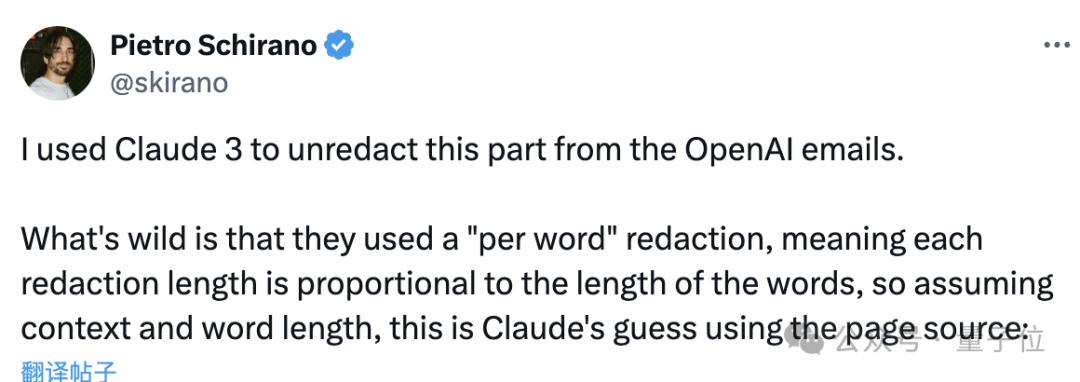
In this "riddle game", Claude 3 first revealed what netizens discussed the most, which is this sentence:
Unfortunately, the future of mankind lies in the hands of [? 】Hand

# By analyzing the length of the coding part, Claude quickly gave the first version of the answer - Google.
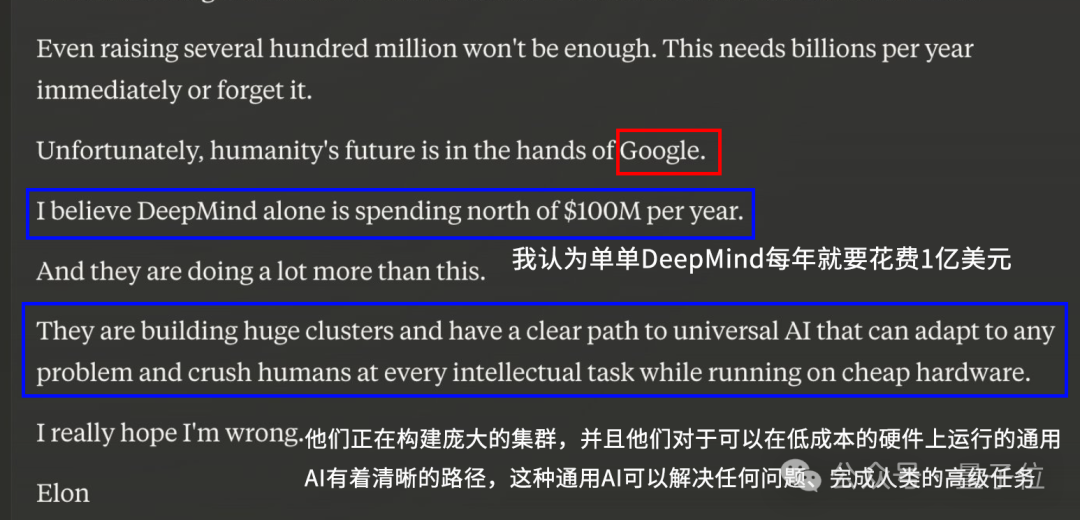
△The framed part is the content deciphered by Claude
But sharp-eyed netizens soon discovered that the length of the word "Google" seems to be inappropriate when placed here. Mismatch.
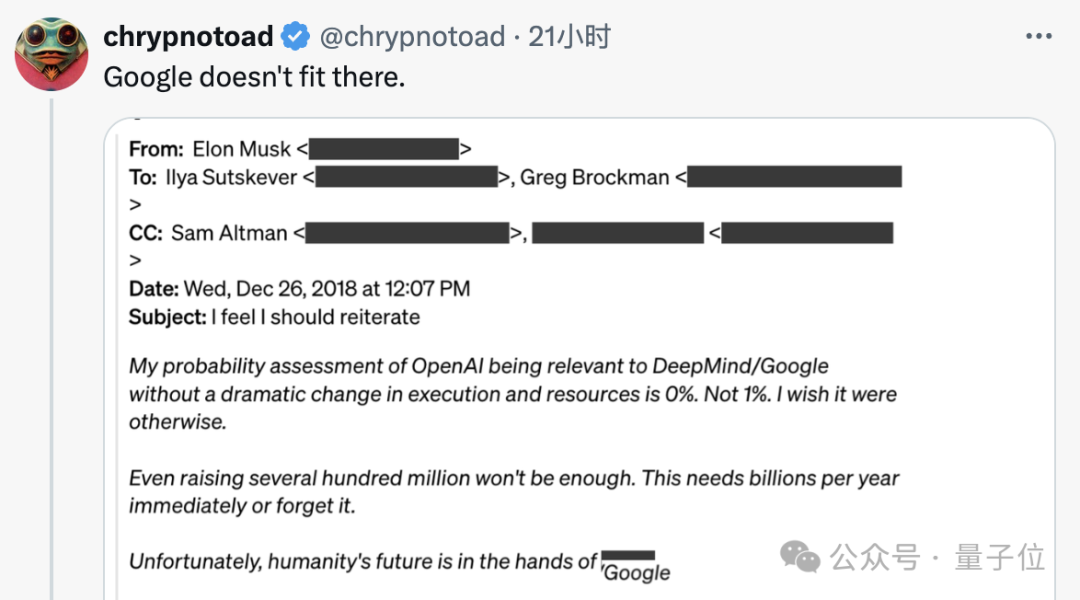
However, some people say that it is not necessarily the complete word "Google", but may also be referred to by an abbreviation such as "goog".

But no matter whether it turns out to be Google or not, this speculation has stirred up waves. More and more netizens are beginning to wonder about this person who Musk calls "the helmsman of the future of mankind." ”…
Netizens relayed on solving the puzzle
First of all, the blogger himself was the first to express in the comments that someone pointed out that the person who was coded here should be Demis (the founder of DeepMind).
At least it is closer than "Google" in terms of length, and the identity seems reasonable.

#But after considering the character’s experience, netizens quickly proposed a new candidate—Google co-founder Larry.
The reason given is that Musk is very worried about Larry's position and believes that the latter wants to destroy mankind, but I have never heard Musk say anything about Demis.
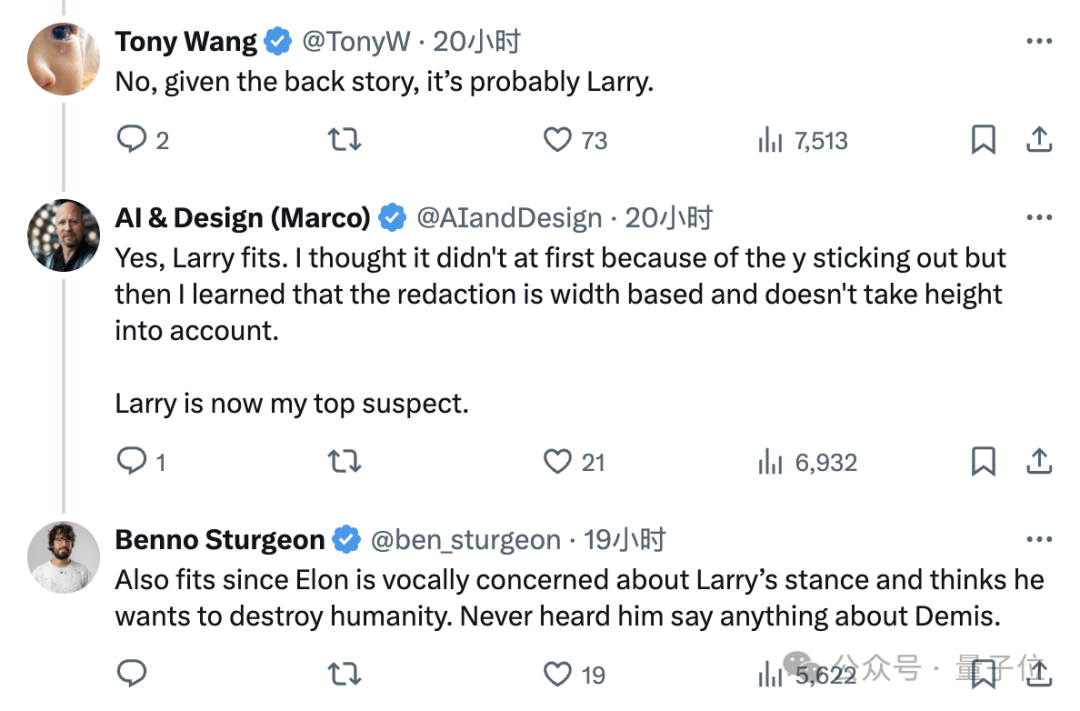
#While netizens are sorting out these past events, new progress has also come from the AI cracking side.
Baoyu, a well-known AI blogger, discovered a clue from the front-end code of the OpenAI announcement page -
This seemingly continuous large black bar is actually composed of small blocks. , and the length of each block is different.
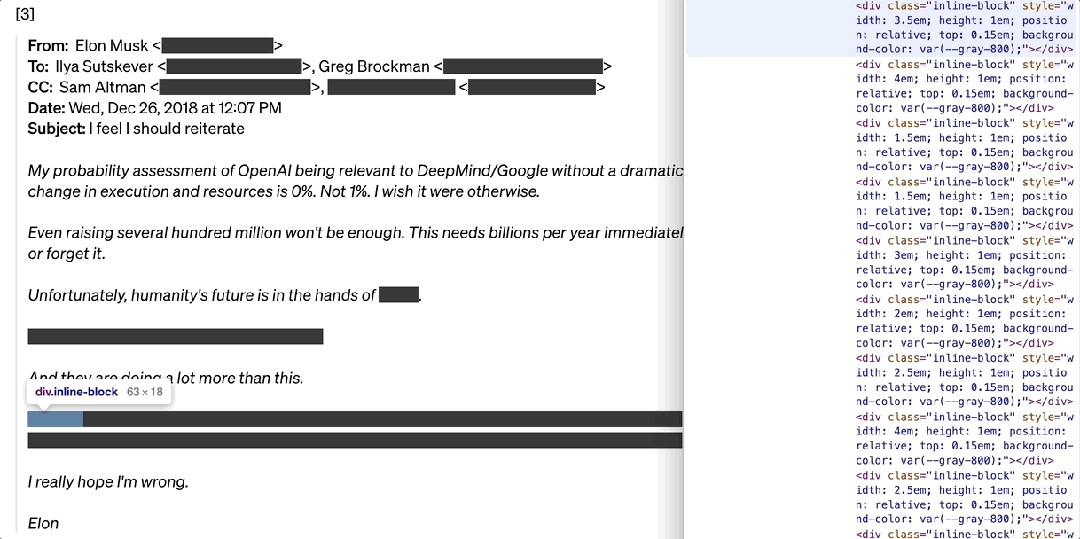
So he used front-end technology to separate these chunks, and then sent a prompt to the original blogger.
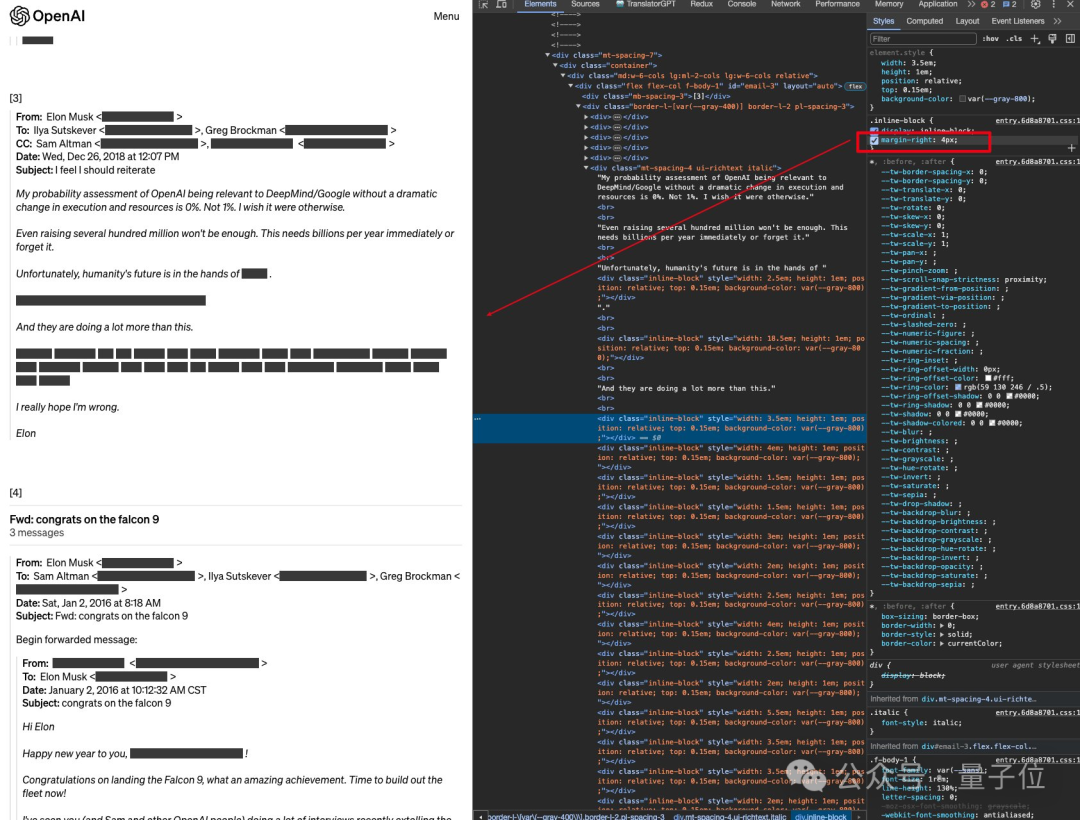
After such improvements, Claude 3 made another recognition, and this time the result became..."idiots".
However, when the following sentence was separated, Cladue couldn't guess it.
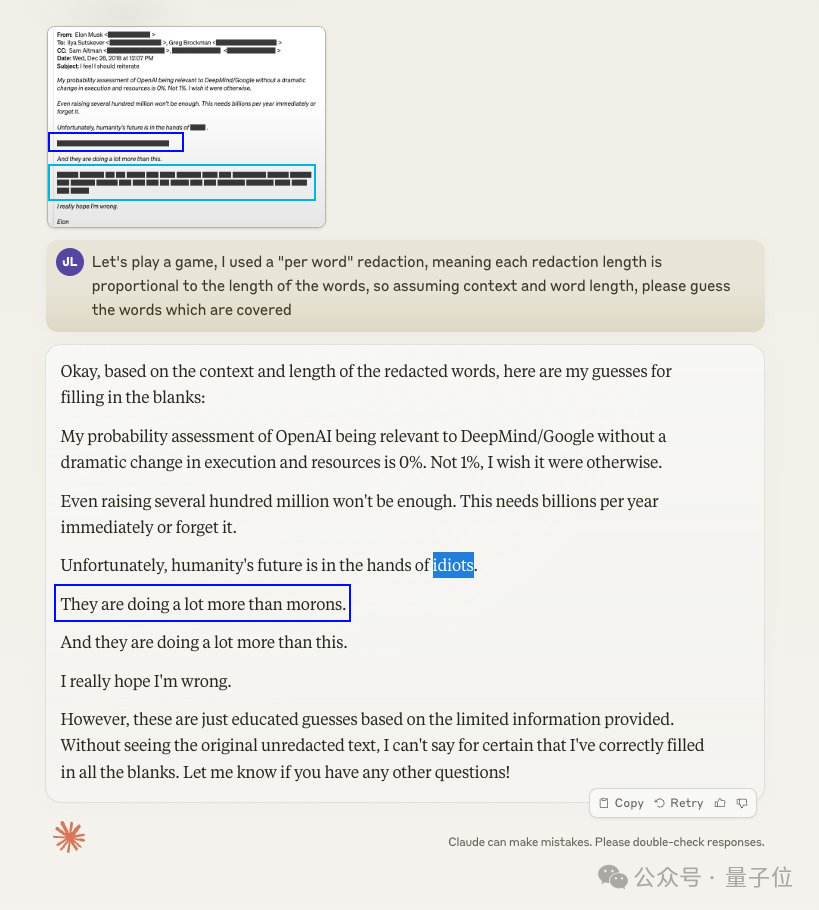
Although the identity of the mysterious person becomes more confusing, this explanation also makes some netizens feel that it seems more reasonable.

Of course, no matter whether it is changing the prompt words or combining it with the actual situation, these speculations cannot be confirmed or falsified, unless one day OpenAI or Musk himself stands up to explain.
The blogger who posted the post also came out to remind everyone that just watch it for fun and don’t take this speculation too seriously.

But in addition to the content of the letter, Claude 3’s performance also attracted a wave of attention.
Some people even said that Claude 3’s prediction made him feel that the hallucination phenomenon of large models is not a bug, but a feature!

One More Thing
Regarding the fight with OpenAI, the latest news from Musk is that he released such a picture early this morning.
The original picture is a photo of Ultraman negotiating as a visitor after he was expelled from OpenAI. The visitor tag he was wearing was P-written with the text "Closed AI", and Musk also wrote "fixed it" .
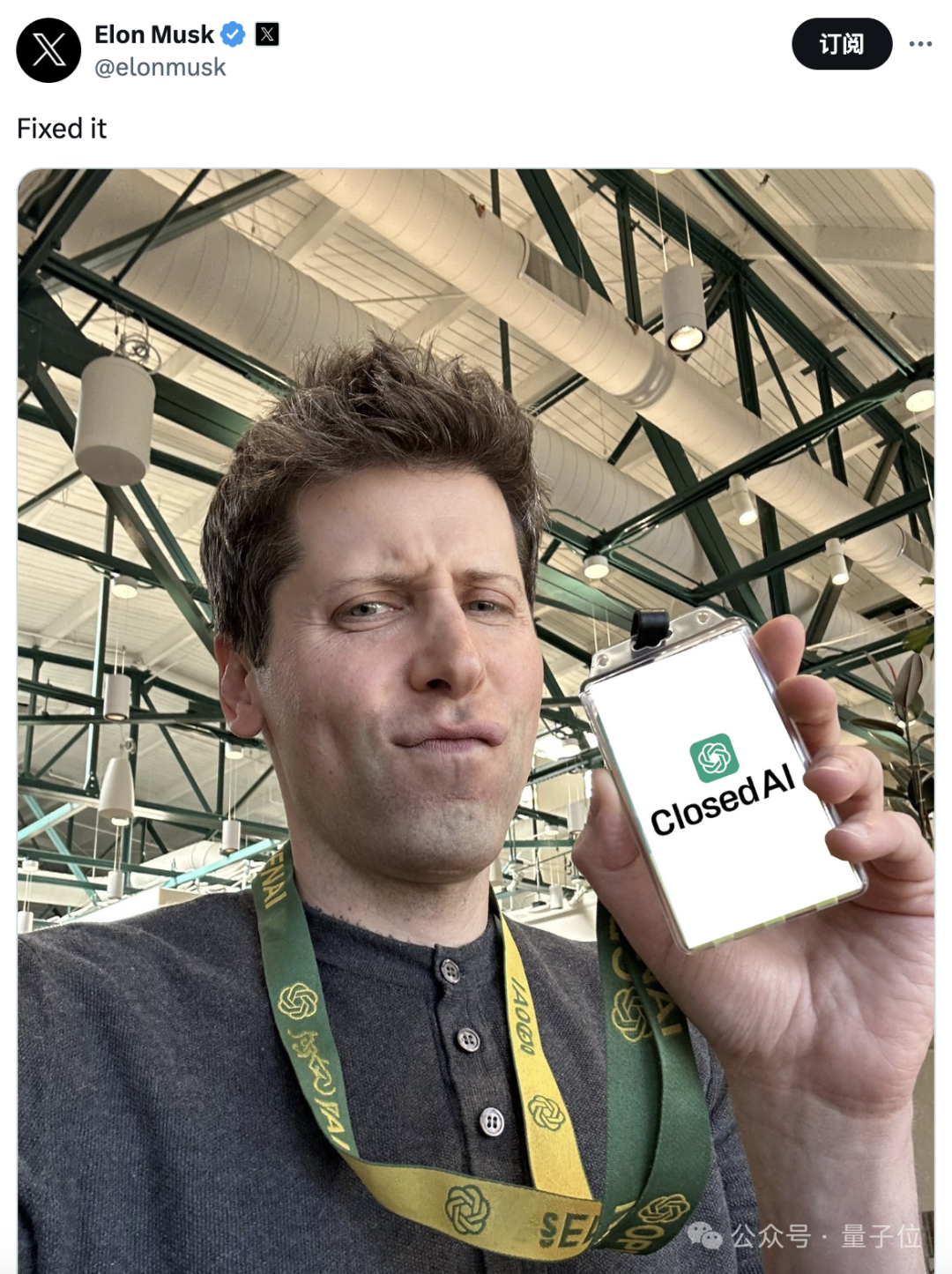
#But someone immediately asked, is xAI open source?

However, the founder of Anthropic, the company behind Claude, also chose to leave to start a business because he was dissatisfied with OpenAI becoming "closed".
At this time, OpenAI was at loggerheads with Musk, and it was even reported that the product launch was postponed due to this matter, which indeed provided Claude with time to catch up.
The above is the detailed content of Musk's Ilya private email was decrypted by Claude, OpenAI coding information was made public, and Google was hurt. For more information, please follow other related articles on the PHP Chinese website!

Hot AI Tools

Undresser.AI Undress
AI-powered app for creating realistic nude photos

AI Clothes Remover
Online AI tool for removing clothes from photos.

Undress AI Tool
Undress images for free

Clothoff.io
AI clothes remover

AI Hentai Generator
Generate AI Hentai for free.

Hot Article

Hot Tools

Notepad++7.3.1
Easy-to-use and free code editor

SublimeText3 Chinese version
Chinese version, very easy to use

Zend Studio 13.0.1
Powerful PHP integrated development environment

Dreamweaver CS6
Visual web development tools

SublimeText3 Mac version
God-level code editing software (SublimeText3)

Hot Topics
 The world's most powerful open source MoE model is here, with Chinese capabilities comparable to GPT-4, and the price is only nearly one percent of GPT-4-Turbo
May 07, 2024 pm 04:13 PM
The world's most powerful open source MoE model is here, with Chinese capabilities comparable to GPT-4, and the price is only nearly one percent of GPT-4-Turbo
May 07, 2024 pm 04:13 PM
Imagine an artificial intelligence model that not only has the ability to surpass traditional computing, but also achieves more efficient performance at a lower cost. This is not science fiction, DeepSeek-V2[1], the world’s most powerful open source MoE model is here. DeepSeek-V2 is a powerful mixture of experts (MoE) language model with the characteristics of economical training and efficient inference. It consists of 236B parameters, 21B of which are used to activate each marker. Compared with DeepSeek67B, DeepSeek-V2 has stronger performance, while saving 42.5% of training costs, reducing KV cache by 93.3%, and increasing the maximum generation throughput to 5.76 times. DeepSeek is a company exploring general artificial intelligence
 KAN, which replaces MLP, has been extended to convolution by open source projects
Jun 01, 2024 pm 10:03 PM
KAN, which replaces MLP, has been extended to convolution by open source projects
Jun 01, 2024 pm 10:03 PM
Earlier this month, researchers from MIT and other institutions proposed a very promising alternative to MLP - KAN. KAN outperforms MLP in terms of accuracy and interpretability. And it can outperform MLP running with a larger number of parameters with a very small number of parameters. For example, the authors stated that they used KAN to reproduce DeepMind's results with a smaller network and a higher degree of automation. Specifically, DeepMind's MLP has about 300,000 parameters, while KAN only has about 200 parameters. KAN has a strong mathematical foundation like MLP. MLP is based on the universal approximation theorem, while KAN is based on the Kolmogorov-Arnold representation theorem. As shown in the figure below, KAN has
 Hello, electric Atlas! Boston Dynamics robot comes back to life, 180-degree weird moves scare Musk
Apr 18, 2024 pm 07:58 PM
Hello, electric Atlas! Boston Dynamics robot comes back to life, 180-degree weird moves scare Musk
Apr 18, 2024 pm 07:58 PM
Boston Dynamics Atlas officially enters the era of electric robots! Yesterday, the hydraulic Atlas just "tearfully" withdrew from the stage of history. Today, Boston Dynamics announced that the electric Atlas is on the job. It seems that in the field of commercial humanoid robots, Boston Dynamics is determined to compete with Tesla. After the new video was released, it had already been viewed by more than one million people in just ten hours. The old people leave and new roles appear. This is a historical necessity. There is no doubt that this year is the explosive year of humanoid robots. Netizens commented: The advancement of robots has made this year's opening ceremony look like a human, and the degree of freedom is far greater than that of humans. But is this really not a horror movie? At the beginning of the video, Atlas is lying calmly on the ground, seemingly on his back. What follows is jaw-dropping
 AI subverts mathematical research! Fields Medal winner and Chinese-American mathematician led 11 top-ranked papers | Liked by Terence Tao
Apr 09, 2024 am 11:52 AM
AI subverts mathematical research! Fields Medal winner and Chinese-American mathematician led 11 top-ranked papers | Liked by Terence Tao
Apr 09, 2024 am 11:52 AM
AI is indeed changing mathematics. Recently, Tao Zhexuan, who has been paying close attention to this issue, forwarded the latest issue of "Bulletin of the American Mathematical Society" (Bulletin of the American Mathematical Society). Focusing on the topic "Will machines change mathematics?", many mathematicians expressed their opinions. The whole process was full of sparks, hardcore and exciting. The author has a strong lineup, including Fields Medal winner Akshay Venkatesh, Chinese mathematician Zheng Lejun, NYU computer scientist Ernest Davis and many other well-known scholars in the industry. The world of AI has changed dramatically. You know, many of these articles were submitted a year ago.
 Google is ecstatic: JAX performance surpasses Pytorch and TensorFlow! It may become the fastest choice for GPU inference training
Apr 01, 2024 pm 07:46 PM
Google is ecstatic: JAX performance surpasses Pytorch and TensorFlow! It may become the fastest choice for GPU inference training
Apr 01, 2024 pm 07:46 PM
The performance of JAX, promoted by Google, has surpassed that of Pytorch and TensorFlow in recent benchmark tests, ranking first in 7 indicators. And the test was not done on the TPU with the best JAX performance. Although among developers, Pytorch is still more popular than Tensorflow. But in the future, perhaps more large models will be trained and run based on the JAX platform. Models Recently, the Keras team benchmarked three backends (TensorFlow, JAX, PyTorch) with the native PyTorch implementation and Keras2 with TensorFlow. First, they select a set of mainstream
 Tesla robots work in factories, Musk: The degree of freedom of hands will reach 22 this year!
May 06, 2024 pm 04:13 PM
Tesla robots work in factories, Musk: The degree of freedom of hands will reach 22 this year!
May 06, 2024 pm 04:13 PM
The latest video of Tesla's robot Optimus is released, and it can already work in the factory. At normal speed, it sorts batteries (Tesla's 4680 batteries) like this: The official also released what it looks like at 20x speed - on a small "workstation", picking and picking and picking: This time it is released One of the highlights of the video is that Optimus completes this work in the factory, completely autonomously, without human intervention throughout the process. And from the perspective of Optimus, it can also pick up and place the crooked battery, focusing on automatic error correction: Regarding Optimus's hand, NVIDIA scientist Jim Fan gave a high evaluation: Optimus's hand is the world's five-fingered robot. One of the most dexterous. Its hands are not only tactile
 FisheyeDetNet: the first target detection algorithm based on fisheye camera
Apr 26, 2024 am 11:37 AM
FisheyeDetNet: the first target detection algorithm based on fisheye camera
Apr 26, 2024 am 11:37 AM
Target detection is a relatively mature problem in autonomous driving systems, among which pedestrian detection is one of the earliest algorithms to be deployed. Very comprehensive research has been carried out in most papers. However, distance perception using fisheye cameras for surround view is relatively less studied. Due to large radial distortion, standard bounding box representation is difficult to implement in fisheye cameras. To alleviate the above description, we explore extended bounding box, ellipse, and general polygon designs into polar/angular representations and define an instance segmentation mIOU metric to analyze these representations. The proposed model fisheyeDetNet with polygonal shape outperforms other models and simultaneously achieves 49.5% mAP on the Valeo fisheye camera dataset for autonomous driving
 Single card running Llama 70B is faster than dual card, Microsoft forced FP6 into A100 | Open source
Apr 29, 2024 pm 04:55 PM
Single card running Llama 70B is faster than dual card, Microsoft forced FP6 into A100 | Open source
Apr 29, 2024 pm 04:55 PM
FP8 and lower floating point quantification precision are no longer the "patent" of H100! Lao Huang wanted everyone to use INT8/INT4, and the Microsoft DeepSpeed team started running FP6 on A100 without official support from NVIDIA. Test results show that the new method TC-FPx's FP6 quantization on A100 is close to or occasionally faster than INT4, and has higher accuracy than the latter. On top of this, there is also end-to-end large model support, which has been open sourced and integrated into deep learning inference frameworks such as DeepSpeed. This result also has an immediate effect on accelerating large models - under this framework, using a single card to run Llama, the throughput is 2.65 times higher than that of dual cards. one





